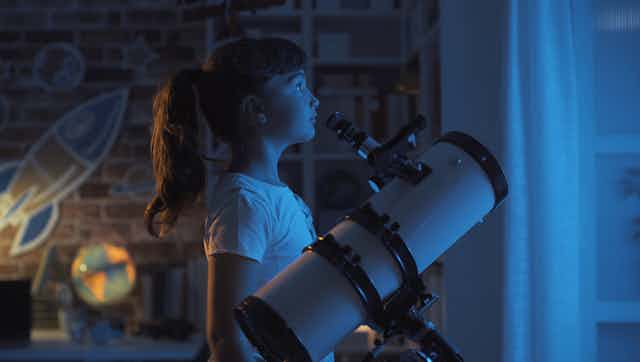What is after space? – Pip, aged four, North Yorkshire, UK
When we look up at a clear night sky, we see space: a vast, seemingly infinite expanse that contains everything we know to exist.
To find out what is beyond space, a good place to start would be to figure out where space – our universe – ends. The problem is we don’t know where space ends, or even if it ends at all.
The furthest we can see out into space, using all the technology we currently have, is 46 billion light years away. The volume of space that we can see is called the observable universe. We don’t know what is out there beyond this. Perhaps it’s more galaxies and stars and space. Perhaps it’s the edge of the universe.

Some people think that the universe is infinite – meaning it goes on forever, in every direction. In this case, there is nothing after space, because space is everything.
But even if the universe did have an end, it might be very difficult for us to figure out where the edge is.

Curious Kids is a series by The Conversation that gives children the chance to have their questions about the world answered by experts. If you have a question you’d like an expert to answer, send it to curiouskids@theconversation.com and make sure you include the asker’s first name, age and town or city. We won’t be able to answer every question, but we’ll do our very best.
Think about our home on planet Earth, for instance. We know that the Earth doesn’t go on infinitely: it ends and space begins. But if you were to set off walking, looking for the edge of the Earth, you’d never get there even if you walked forever. This is because Earth is a sphere. To figure out that the Earth has an edge, and where it is, we need to know its shape.
Understanding the shape of the universe, might help us figure out where its edge is. Astronomers are studying the universe right now, looking for clues that might tell us more about its shape.
Understanding the universe
We know what the whole of the Earth looks like because we have been able to take pictures of it from space – and some astronauts have been up to space to see it. Perhaps we would be able to see the edge of the universe too, if we knew where to go to look for it.
There’s another problem, though. The universe is expanding – and at faster speeds. The space between us and other galaxies is growing. As they get further away, it takes more time for the light from these distant galaxies to reach us.
At some point they will be so far away that the light won’t reach us at all. The night sky will be completely dark, and we will have very little chance of seeing an edge if one exists. This expansion of the universe might mean that the edge – and whatever is after it – is getting further away from us, too.
Even though we don’t know where the edge of our universe is, scientists still spend a lot of time thinking about what comes after it.
A multiverse?
It’s possible that there isn’t just one universe, and that beyond our universe there are others. We could be living in just one small part of a “multiverse”.

Perhaps our universe is contained within its own distinct region of space, separated from other universes by vast expanses of nothingness. Or maybe there are parallel universes squashed up close to one another, or even overlapping. This would mean there is no real “edge” at all, but universes blending into one another.
The true nature of the universe could be beyond our current ability to visualise or comprehend. Understanding the shape of the universe may help us to find out whether it goes on forever or has an end. What comes after that could be an even greater mystery.


